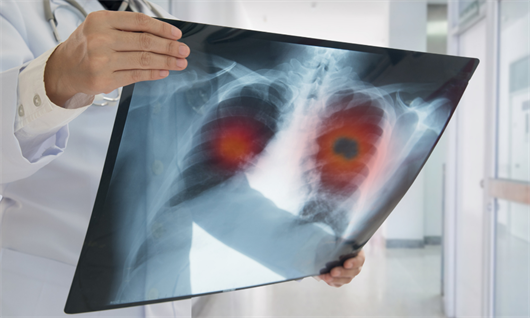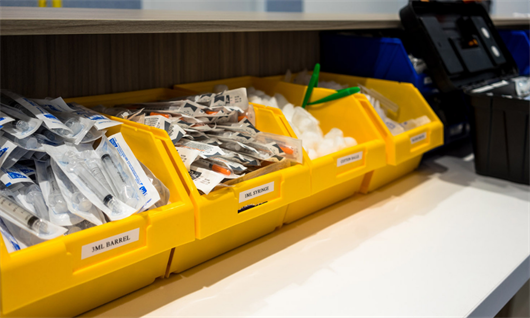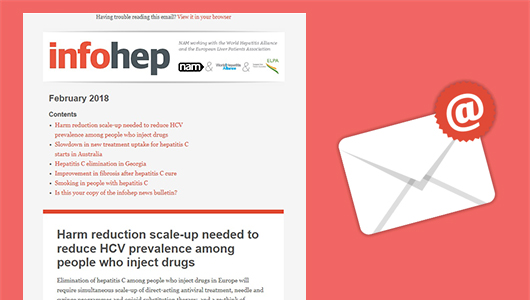Having trouble reading this email? View it in your browser
| |
January 2022 | |
Some people remain at risk for liver cancer despite hepatitis C treatment
Rido/Shutterstock.com Some people with liver cirrhosis remain at risk for developing hepatocellular carcinoma (HCC) even after hepatitis C treatment, according to study results presented at the AASLD Liver Meeting last November. Not achieving a cure was the biggest risk factor. A related study found that among people who were cured, HCC risk factors differed for people with and without cirrhosis. People who are successfully treated for hepatitis C are less likely to develop HCC, but some risk remains, especially for those who have already progressed to advanced fibrosis or cirrhosis. Italian researchers looked at 2214 people with hepatitis C and cirrhosis who were treated with direct-acting antivirals and followed for at least a year after being treated. Ninety-three per cent were cured of hepatitis C and after a median follow-up of 30 months, 6.7% developed HCC for the first time. The risk of developing HCC was seven times higher in people who were not cured of hepatitis C. In people cured of hepatitis C, genotype 3 infection, low albumin level and older age were independent risk factors for developing HCC. In a second study, of 98,612 US military veterans treated for hepatitis C, annual HCC incidence rates for people with cirrhosis were 1.6% during the first year post-treatment and 1.9% during the second year, compared with 0.21% and 0.27%, respectively, for those without cirrhosis. The researchers found that liver cancer risk factors differed based on cirrhosis status. Among people with cirrhosis, HCC predictors at 12 months included male sex, White race, HCV genotype 3, longer cirrhosis duration, higher bilirubin levels and the presence of oesophageal varices. Changes in albumin levels and worsening fibrosis (as indicated by FIB-4 score) also predicted HCC risk. However, race, HCV genotype and bilirubin were no longer significant predictors at 24 months while changes in haemoglobin level became a significant factor. Non-smokers had a lower HCC risk. Among people without cirrhosis, metabolic factors such as diabetes and hypertension, as well as worsening fibrosis, were strongly associated with HCC risk at both time points. These findings could inform decisions about HCC surveillance in people cured of hepatitis C, say the US researchers. Because risk factors can change over time, they suggested that repeated assessment at two years "is practical and can improve risk stratification" in patients cured of hepatitis C, regardless of their cirrhosis status. HCC after sustained virological response has been observed in past studies in people with cirrhosis. The EASL guidelines for HCC (2018) recommend screening patients with cirrhosis for HCC every six months. Bulevirtide for hepatitis D proves effective in real-world studiesThe entry inhibitor bulevirtide (Hepcludex) led to a reduction in hepatitis delta virus (HDV) viral load and improved liver enzyme levels in real-world studies in France and Austria, according to findings presented at The Liver Meeting. Several other studies shed more light on the prevalence and outcomes of hepatitis D. Hepatitis delta is a defective virus that can only replicate in the presence of hepatitis B virus (HBV). It is estimated that around 15 million people worldwide have HDV. Bulevirtide (formerly known as Myrcludex) blocks surface receptors that HBV uses to enter liver cells. This interferes with the hepatitis B lifecycle and thereby also prevents HDV replication. In July 2020, the European Medicines Agency (EMA) granted conditional approval of bulevirtide as the first ever treatment for hepatitis D. Gilead Sciences submitted an application for approval to the US Food and Drug Administration in October 2021. Prof. Victor De Ledinghen of Bordeaux University Hospital in France and colleagues looked at outcomes from the French early access programme. The analysis included 145 people with chronic HBV/HDV co-infection who either had advanced fibrosis or compensated cirrhosis or moderate fibrosis and elevated ALT levels. Looking at a combined endpoint of undetectable HDV viral load or at least a 2-log decline in HDV RNA plus ALT normalisation, 39% on bulevirtide alone and 30% on bulevirtide and pegylated interferon met both metrics. In another analysis, Teresa Binter of the Medical University of Vienna and colleagues assessed 17 people who received bulevirtide, first through a compassionate use programme and then through the Austrian health insurance system. About 80% of patients saw at least a 2-log reduction in HDV RNA and about 90% experienced ALT normalisation at 48 weeks. Four people achieved viral load suppression for at least six months while on treatment. “To eradicate HDV, long-term treatment is needed. A response-guided approach is recommended,” the investigators concluded, noting that an individualised approach is needed. Hepatitis B may increase cancer risk in people with HIV
create jobs 51/Shutterstock.com People with both HIV and hepatitis B have a higher rate of non-liver cancers compared to other people with HIV, a large European study has found. The study investigators, who have published their findings in the journal HIV Medicine, say that people with HIV and hepatitis B co-infection may need extra screening for some common cancers. The study found that the rate of non-liver cancers was 23% higher in people with HIV and hepatitis B compared to people with HIV alone. Between 2001 and 2019, 1298 people in the sample developed 1360 non-liver malignancies. The most common cancers were anal cancer (188 cases), lung cancer (147 cases) and non-Hodgkin lymphoma (131 cases). The investigators found a non-significant trend towards a higher rate of anal cancer in people with hepatitis B and HIV and a significantly higher rate of non-Hodgkin lymphoma in people who were HBV-DNA-positive (adjusted incidence rate ratio 2.57). However, in both cases the absolute number of cases in people with hepatitis B was small. Related linksOne in five new cases of hepatitis C in people who inject drugs due to unstable housing, modelling shows
Photographee.eu/Shutterstock.com Unstable housing may be responsible for up to one in five new infections with HIV or hepatitis C among people who inject drugs in the United Kingdom and the United States, a global modelling study has found. A systematic review and meta-analysis of 37 studies published in 2021 showed that unstable housing increased the risk of hepatitis C infection by 64% and HIV infection by 39% in people who inject drugs. The impact of unstable housing on HIV and hepatitis C transmission is greatest in high-income countries, the model showed. Unstable housing will account for 21% of new HIV infections and 26% of new hepatitis C infections between 2020 and 2029 in North America. In comparison, unstable housing will account for 6% of new HIV infections and 8% of new hepatitis C infections in lower- and middle-income countries. A small number of countries contribute disproportionately to the global total. Six countries – Afghanistan, the Czech Republic, England, India, the United States and Wales – will account for 29% of global HIV infections and 44% of global hepatitis C infections attributable to unstable housing in people who inject drugs. In each country, unstable housing will contribute more than 20% of new HIV and hepatitis C infections in people who inject drugs between 2020 and 2029. Those countries contributing most to the global burden of new infections in the unstably housed have a high prevalence of unstable housing in people who inject drugs. More than 40% of people who inject drugs are estimated to be unstably housed in the Czech Republic, England and the United States compared to Russia (4%) or China (8%). “With the UNAIDS beginning to incorporate social enablers into their target setting, including for key populations, it is essential to strive for improved access to stable housing for people who inject drugs,” the study authors advocate. “HIV and HCV elimination targets will be missed unless the effect of these structural drivers [is] mitigated.” However, they say it is unlikely stable housing alone will be sufficient to eliminate the excess risk observed in this study. “Interventions must go beyond simply providing stable housing by addressing individuals’ broader health and social needs and providing access to prevention and treatment services.” Re-infection with hepatitis C has fallen among people with HIV in EuropeThe rate of re-infection with hepatitis C has fallen sharply among people with HIV in Europe since the introduction of direct-acting antivirals, the EuroSIDA cohort study reports in the journal HIV Medicine. The analysis identified 1022 people in the EuroSIDA cohort of people with HIV in Europe who had been cured of hepatitis C, had at least two years of follow-up and had been tested for hepatitis C RNA during follow-up. The analysis showed that risk of re-infection was nearly 80% lower in people treated with direct-acting antivirals in 2014 or after (adjusted odds ratio 0.21, 95% confidence interval 0.11-0.38) and around 55% lower in those who received interferon-based treatment in 2014 or after (AOR 0.43, 95% CI 0.22-0.83), when compared to people treated before 2014. The study investigators say that a possible explanation for the reduced risk of re-infection after 2014 is the effect of wider treatment availability and uptake on the prevalence of hepatitis C. A reduction in the number of people with hepatitis C would lead to a reduction in the chance of acquiring hepatitis C. Related linksPrioritise harm reduction services to prevent hepatitis C re-infection, Scottish study finds
Nigel Brunsdon/nigelbrunsdon.com Limiting re-infection with hepatitis C in people who use drugs is most likely to be achieved by intensifying provision of sterile injecting equipment for people using needle and syringe programmes and increasing the number of people who inject drugs who are treated, rather than withholding treatment for people who inject drugs until they stop injecting, a Scottish study suggests. The study looked at rates of re-infection according to a person’s pathway to treatment in the Tayside region of Scotland. The region has a high prevalence of hepatitis C and efforts to eliminate hepatitis C have used multiple pathways to reach people with testing and treatment services. People in Tayside may have been diagnosed and treated through one of six pathways: community pharmacies, drug treatment centres, prisons, injection equipment provision sites, nurse-led outreach services or hospital outpatient clinics. The highest rate of re-infection was observed in people treated through injection equipment provision sites (19.89 per 100 person-years of follow-up). The lowest rates were seen in people treated through the hospital outpatient clinic (1.81 per 100 PYs) and drug treatment clinics (3.13 per 100 PYs). The investigators say their results suggest that resources should be targeted at injection equipment provision sites to prevent re-infections. Opioid substitution treatment and high coverage needle and syringe programmes are likely to prevent a proportion of re-infections but reducing community viral load by increasing the number of people who inject drugs who are treated and cured will also be essential to prevent re-infection. Related linksIs this your copy of the infohep news bulletin?
Is this your copy of the infohep news bulletin, or did you receive it from a friend or colleague, or find it online? You can sign up to receive this monthly email bulletin, free of charge, on our website, where you can also find an archive of all the infohep news bulletins. | |
 Latest treatment news and information for patient advocates and people working in hepatitis in Europe. For more details, please contact: To unsubscribe please click here Privacy Policy |







Connect with infohep on Facebook: Keep up to date with all the latest news and developments.
Follow infohep on Twitter for links to news stories and updates from infohep.org. Follow us at www.twitter.com/infohep.
Follow all the infohep news by subscribing to our RSS feeds.